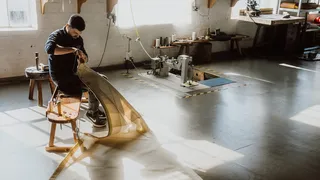Ratsey & Lapthorn, the centuries-old sailmaker behind some of yachting’s most storied vessels, is venturing into lifestyle with a new line of handmade luxury bags that blend heritage craftsmanship with modern innovation...
It’s not often that a company that is both a respected name in the world of boatbuilding and a centuries-old heritage brand branches out into the comparably modern world of lifestyle accessories. But then it’s not often that you come across a business quite like Ratsey & Lapthorn.
The company in its present form is an amalgamation of two 18th-century firms: Ratsey Sailmakers, which made the sails for HMS Victory and was established by George Rogers Ratsey in Cowes on the Isle of Wight in 1790, and James Lapthorn’s loft, which was set up nearby on the UK mainland in Gosport a few years later, and found renown as the sailmakers for the first British America’s Cup challenger Cambria.
After the two competing businesses established a dominance in the market over the course of the next decades, the pair merged in 1889 to become Ratsey & Lapthorn Ltd, and in the 136 years since has been the go-to loft for handcrafted sails for boats of all sizes, from the 67-metre Second World War schooner Migrant, Astilleros de Mallorca’s Adix, and more recently the refit of Camper and Nicholson’s 29-metre Cynara, having made the original sails when she was built in 1927.
In 1902, in an era that saw “the advent of yachting as a sport and a gentleman’s pursuit”, as CEO Jim Hartley puts it, the company established a New York loft – where the first client was J P Morgan Senior with his much-loved Corsair III. This was followed by an expansive space on City Island, which became the largest sail loft in the world, all the while both HQs on either side of the Atlantic were kitting out competing entrants for each edition of the America’s Cup.
Each Ratsey & Lapthorn sail to this day – be it commissioned for cruising, racing or classic yachts – is hand-stitched with skills honed over generations, and the company continues its apprenticeship scheme, training up youngsters to develop careers in the art of sailmaking and ensuring that the company stays, as Hartley says, “the go-to suitor for classic sails, with a craftsmanship that has been handed down from master to apprentice and never been broken.”
Emblazoned across the wall at Ratsey & Lapthorn HQ – still based in Cowes, 200 years on – is the saying “There’s only one standard of work in this loft and that is the very best,” an 1833 quote from then-president Tom Ratsey. “It’s a guiding light for us in every decision we make,” says Hartley. He explains that the firm is “one of the few – if not the only – remaining sail lofts in the world that does all of those beautiful details: the hand-sewn rings, the leather work, the rat tailing.”
Now Jim Hartley and executive chairman Simon Brazier – who, since taking on the company in 2017, have spent the last eight years making sure the sailmaking side of the business is in top shape – are aiming for new horizons: expanding on the artisanal expertise of the company’s sail-making skills to develop a line of luxury yet seaworthy accessories.
This autumn saw the launch of a range of eight handmade totes, duffel bags, folios and pouches. Every piece is limited edition, made by hand and – truly bringing the brand into the 21st century – each is embedded with Near Field Communication technology to track its journey and ownership.
The designs are simple and elegant with an underlying mariner’s aesthetic: hand-stitched brass eyelets, the Ratsey diamond stitch usually seen in a sail’s high-stress points, and intricate rats’ tails that have become a signature of the brand – so much so that the two smallest pieces in the collection are the Rat pouch and its mini, cut to resemble the shape of a ship’s rodent.
The large, weighty tote bags are inspired by those originally made by the New York loft in the early 1900s; designed to carry coal and ice to yachts before refrigeration and heating were invented, they’re now the perfect size and shape for a weekend trip. Meanwhile, the star of the show, the Ditty, is based on the pieces that apprentice sailmakers would historically use to showcase their skills.
Handmade in a three-step process, the bags are constructed by Somerset-based artisan Katie Robarts-Arnold before arriving at the sail loft where the team insert the eyelets and refine the leather base; then Sue Pennison, chair of trustees of the International Guild of Knot Tyers, finishes the ropework.
Each piece has its own charm – both in its design and because, at the point of sale, clients can choose a unique knot of their own, representing a multitude of good fortunes, be it in travel, love, luck or eternity – fitting, perhaps, for a business that embodies the age-old love of life on the water. ratseyandlapthorn.com
First published in the December 2025 issue of BOAT International. Get this magazine sent straight to your door, or subscribe and never miss an issue.

